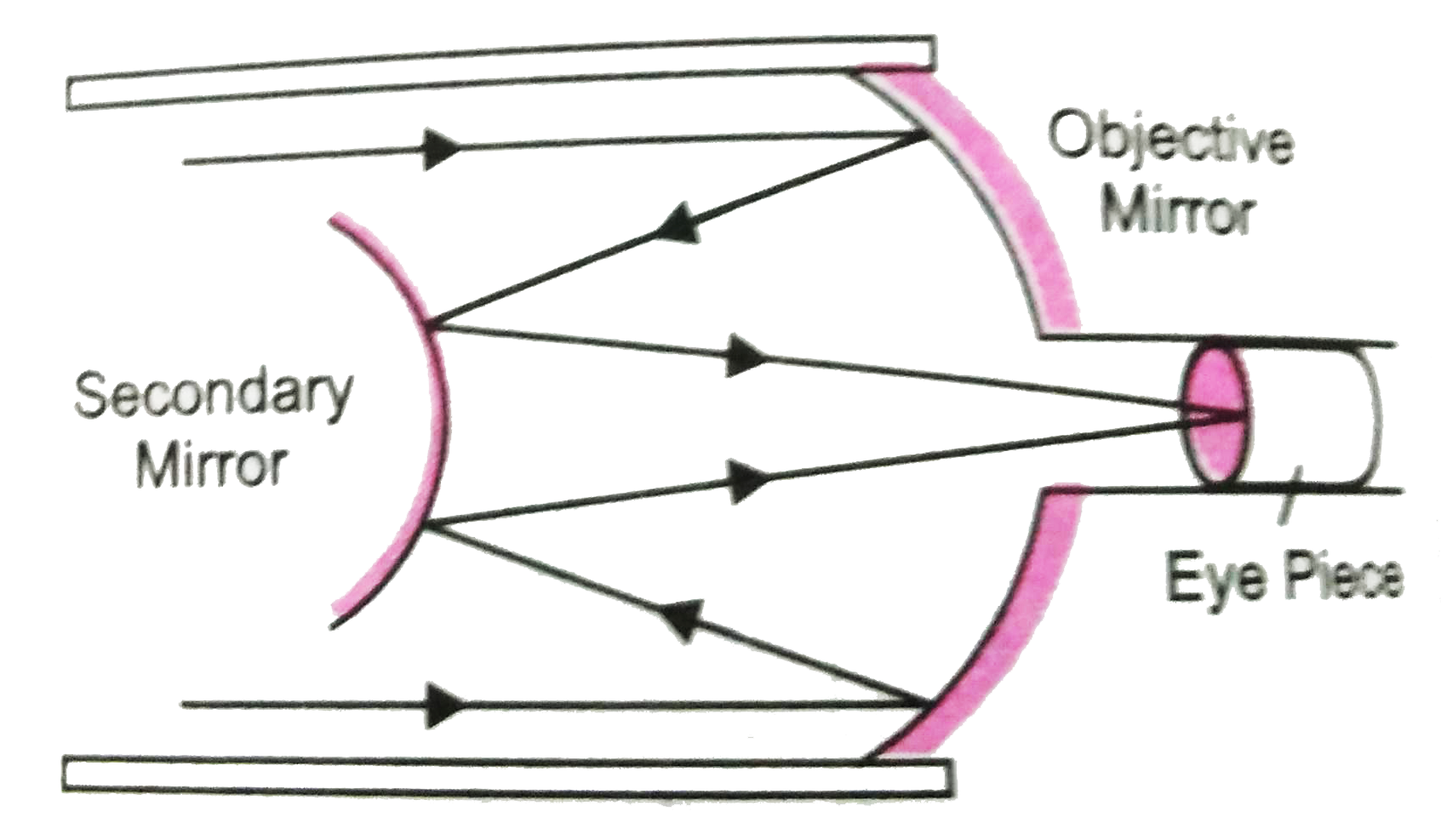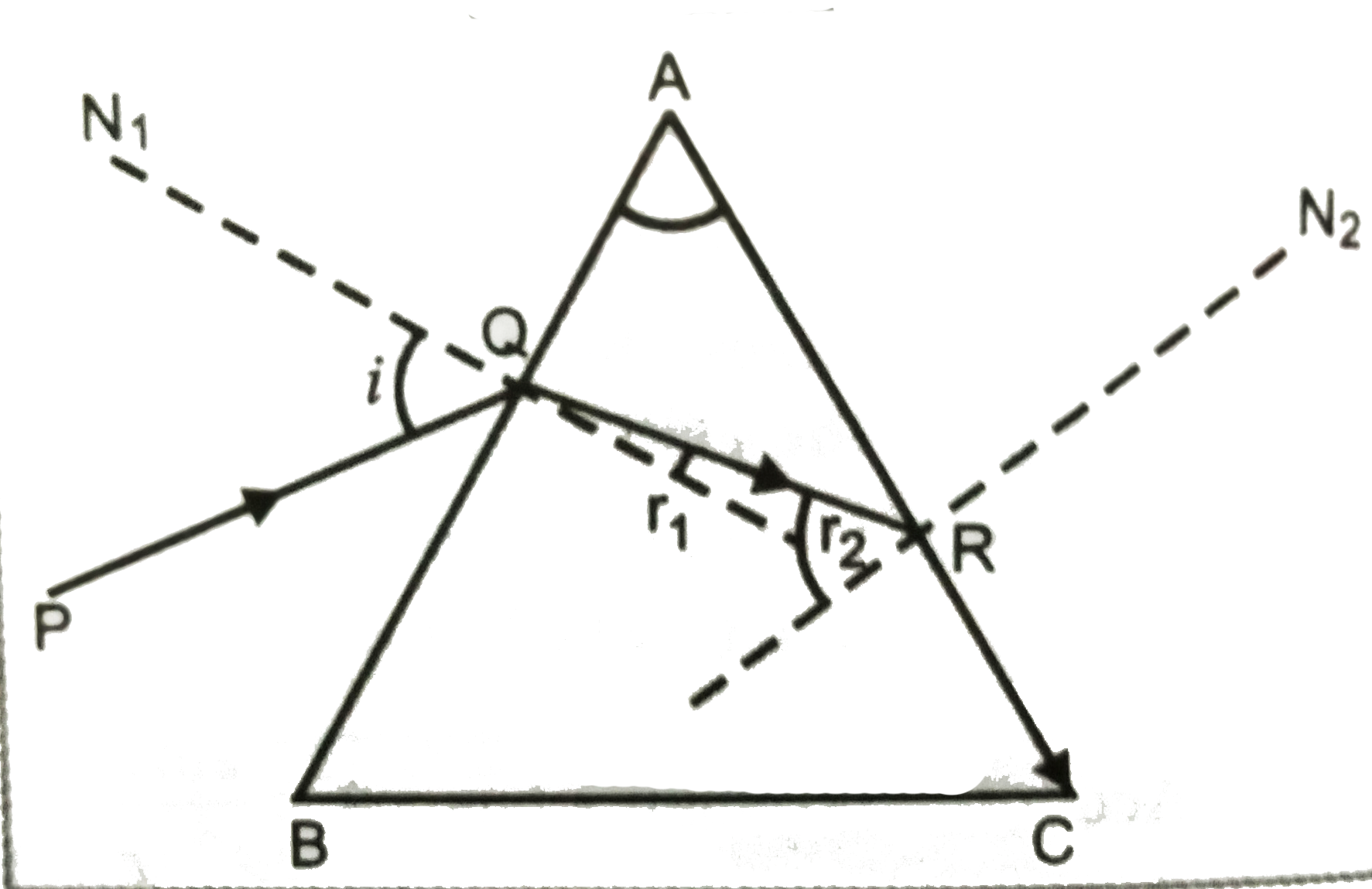(NCERT)Long Answer from PRADEEP PHYSICS (HINGLISH) RAY OPTICS for Class 11
| Class 11 | PHYSICS |
| Chapter | RAY OPTICS |
| PRADEEP PHYSICS (HINGLISH) | (NCERT)Long Answer |
| Medium | English |
| Academic Year | 2023-2024 |
Question 27
A transparent cube of side 210mm contains a small air bubble. Its apparent distance, when viewed from one face of the cube is 100mm, and when viewed through opposite face is 40mm. What is the actual distance of the bubble from the second face and what is the refractive index of the material of the cube ?View SolutionQuestion 33
A point source of light S is placed at the bottom of a vessel containing a liquid of refractive index 5/3. A person is viewing the source from above the surface. There is an opaque disc of radius 1cm floating on the surface. The centre of disc lies vertically above the source O. The liquid from the vessel is gradually drained out through a tap. What is the maximum height of the liquid for which the source cannot be seen at all. View SolutionQuestion 64
(i) If f=+0.5m, what is the power of the lens ?
(ii) The radii of curvature of the faces of a double convex lens are 9cmand15cm. Its focal length is 12cm. What is the refractive index of glass ?
(iii) A convex lens has 20cm focal length in air. What is the focal length in water ? (Refractive index of air-water =1.33, refractive index of air-glass =1.5).View SolutionQuestion 71
A convex lens and a convex mirror of radius of curvature 20cm are placed co-axially with the convex mirror placed at a distance of 30cm from the lens. For a point object at a distance of 25cm from the lens, the final image due to this combination coincides with the object itself. What is the focal length of convex lens ?View SolutionQuestion 80
A beam of light of wavelength 400nm is incident normally on a right angled prism as shown in Fig.
It is observed that light just grazes along the surface AC after falling on it. If refractive index μ of the material of prism varies with wavelength
λ as μ=1.2+bλ2
Calculate the value of bandμ of prism material for λ=500nm. Given θ=sin−1(0.625).
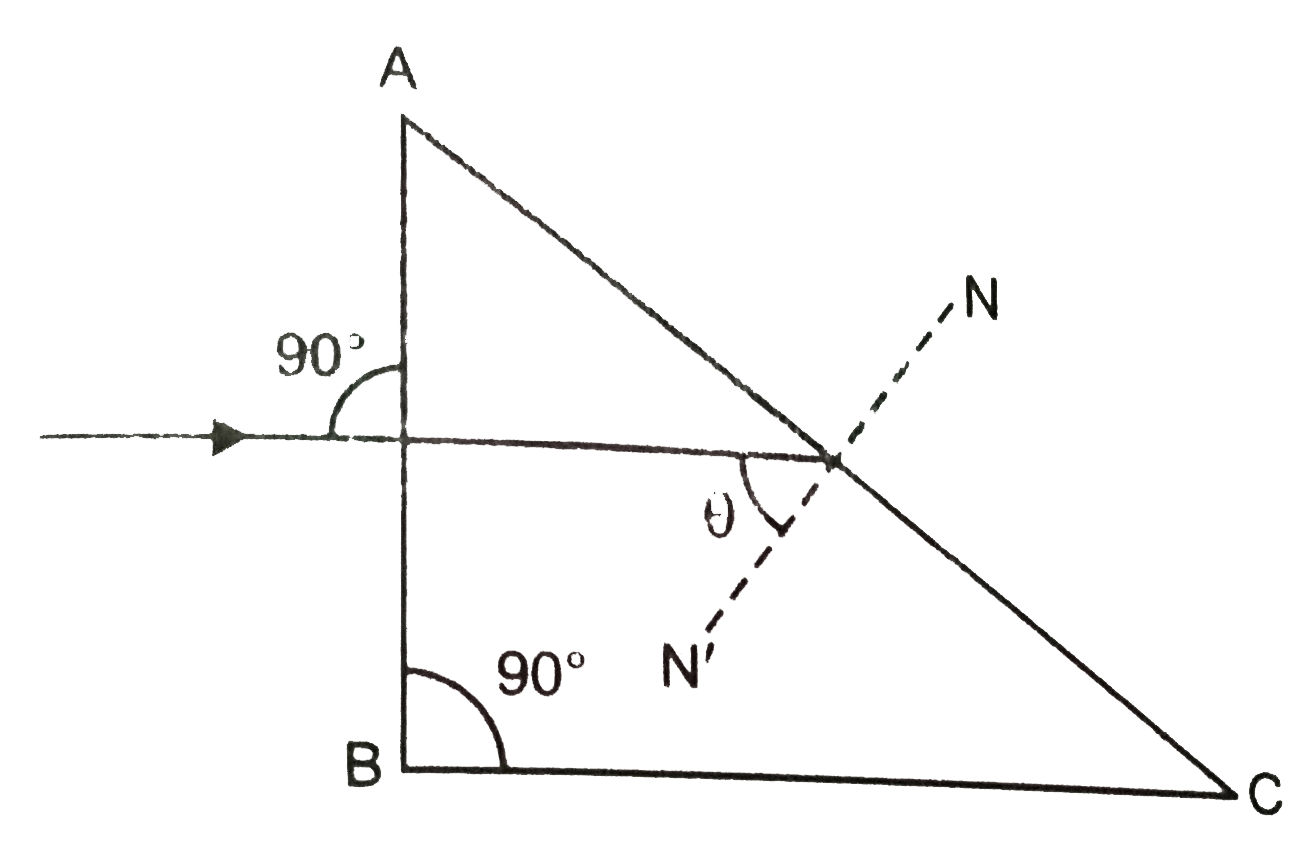 .View Solution
.View SolutionQuestion 87
A ray PQ incident on face AB of a prism ABC, as shown in Fig., emerges from the face AC such that AQ=AR. Draw the ray diagram showing the pasage of the ray through the prism. If the angle of prism is 60∘ and refractive index of the material of the prism is √3, determine the values of angle of incidence and angle of deviation.
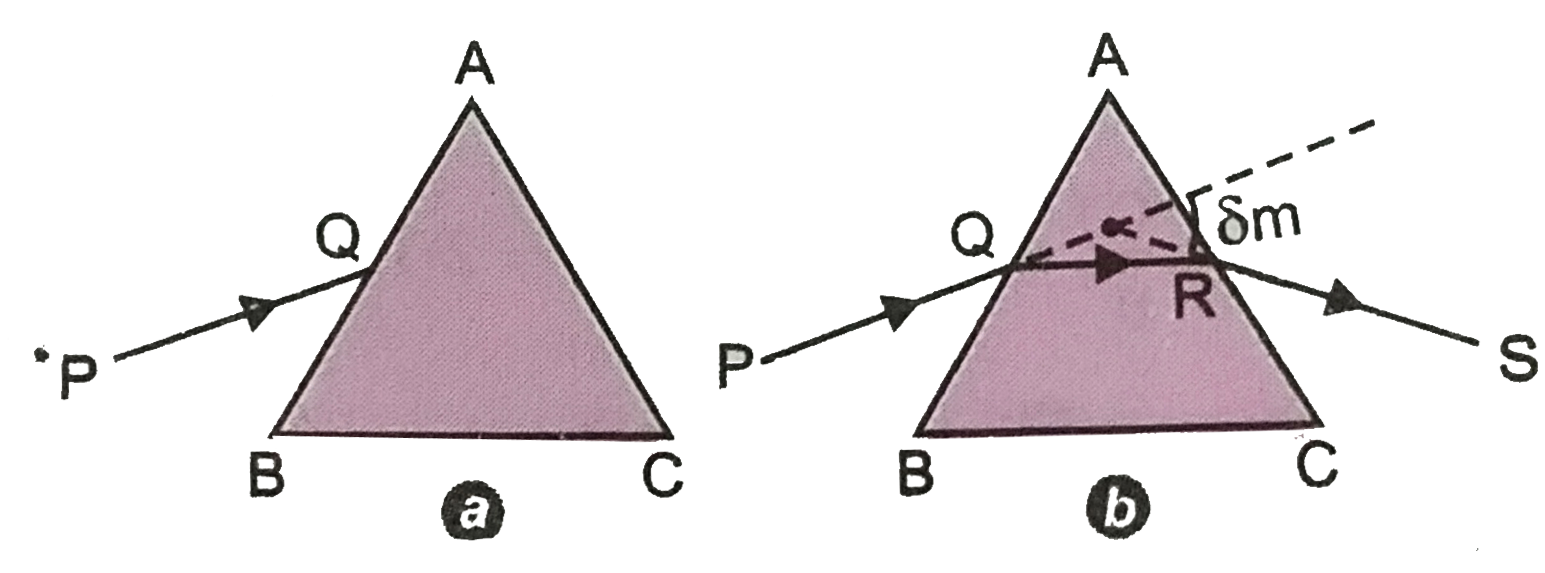 .View Solution
.View SolutionQuestion 93
A combination of two prisms, one of flint and other of crown glass produces dispersion without deviation. The angle of flint glass prism is 15∘. Calculate the angle of crown glass prism and angular separation of red and violet rays on emergence from the spectroscope. (μ for crown glass =1.52,μ for flint glass =1.65,ω for crown glass =0.02,ω for flint glass =0.03).View SolutionQuestion 97
A ray of light is incident at an angle of 60∘ on the face of a prism having refracting angle 30∘. The ray emerging out of the prism makes an angle 30∘ with the incident ray. Show that the emergent ray is perpendicular to the face through which it emerges and calculate the refractive index of the material of prism.View SolutionQuestion 100
A prism is made of glass of unknown refractive index. A parallel beam of light is incident on a face of the prism. By rotating the prism, the minimum angle of deviation is measured to be 40∘. What is the refractive index of the prism ? If the prism is placed in water (μ=1.33), predict the new angle of minimum deviation of the parallel beam. The refracting angle of prism is 60∘.View SolutionQuestion 109
(a) The far point of a myopic person is 80cm. In front of the eye. What is the power of the lens required to enable him to see very distant objects clearly ?
(b) In what way does the corrective lens help the person above ? Does the lens magnify very distant objects ? Explain carefully.
( c) The person above prefers to remove his spectacles while reading a book. Explain why ?View SolutionQuestion 110
(a) The near point of a hypermetropic person is at 75cm from the eye. What is the power of the lens required to enable him to read clearly a book held at 25cm from the eye ?
(b) In what way does the corrective lens help the person above ? Does the lens magnify objects held near the eye ?
( c) The person above prefers to remove his spectacles while looking at the sky. Explain why ?View SolutionQuestion 117
A compound microscope uses an objective lens of focal length 4cm and eye lens of focal length 10cm. An object is placed at 6cm from the objective lens. Calculate magnifying power of compound microscope if final image is formed at the near point. Also, calculate length of the tube of compound microscope.View SolutionQuestion 118
A man with normal near point (25 cm) reads a book with small print using a magnifying glass : a thin convex lens of focal length 5cm.
(a) What are the closest and the farthest distances at which he can read the book when viewing through the magnifying glass ?
(b) What is the maximum and the minimum angular magnifications (magnifying powers) possible using the above simple microscope ?View SolutionQuestion 119
You are given two converging lenses of focal lengths 1.25 cm and 5cm to design a compaound microscope.if it is desired to have a magnification of 30, find out the separation between the object and the eyepiece.
or
A small telescope has an objective lens of focal length 150 cm and eyepiece of focal length 5 cm. What is the magnifying of the telescope for viewing distant objects on normal adjustment ?
If this telescope is used to view a 100 m tall tower 3 km away, what is the height of the image of the tower formed 3km away, what is the height of the image of the tower formed by the objective lens ? View SolutionQuestion 122
The total magnification produced by a compound microscope is 20. The magnification produced by the eye piece is 5. The microscope is focussed on a certain object. The distance between the objective and eye piece is observed to be 14cm. If least distance of distinct vision is 20cm, calculate the focal length of objective and eye piece.View SolutionQuestion 128
A telescope has an objective of focal length 50cm and eye piece of focal length 5cm. The least distance of distinct vision is 25cm. The telescope is focussed for distinct vision on a scale 200cm away from the objective. Calculate
(i) the separation between objective and eye piece
(ii) the magnification produced.View SolutionQuestion 132
The separation between the eye piece of focal length 0.3m and objective of focal length 0.4m of a microscope is 0.2m. The eye piece and objective are to be interchanged such that the angular magnification of the instrument remains the same. What is the new separation between the lenses ?View SolutionQuestion 148
Following data was recorded for values of object distance and the corresponding values of image distance, in the study of real image formation by a convex lens of power +5D. One of these observations is incorrect. Identify and give reason :
(S.No,1,2,3,4,5,6),(Object distance (cm),25,30,35,45,50,55),(Image distance (cm).97,60,37,35,32,30)View SolutionQuestion 176
(a) List some advantanges of a reflecting telescope, especially for high resolution astronomy.
(b) A reflecting type telescope has a large mirror for its objective with radius of curvature equal to 80cm. What is the magnifying power of telescope if eye piece used has a focal length of 1.6cm ?View SolutionQuestion 291
A microscope is focussed on a dot on the bottom of the beaker. Some oil is poured into the beaker to a height of ycm and it found necessary to raise the microscope through a vertical distance of xcm to bring the dot again into focus. Express refractive index of oil in terms of xandy.View SolutionQuestion 325
Using the data given below, state which two of the given lenses will you prefer to construct a best possible (i) telescope (ii) microscope. Also, indicate which of the selected lenses is to be used as an objective and as an eye piece in each case
Lenses,L1,L2,L3
Power(P), 6 D,3 D, 10 D
Aperture (A), 1 cm, 8 cm, 1 cm.View SolutionQuestion 326
Four double convex lenses with following specifications are available
Lens, A, B, C, D,
focal length, 100 cm, 100 cm, 0 cm, 5 cm,
aperture, 10 cm, 5 cm,2 cm, 2 cm.
Which of the given four lenses should be selected as objected and eyepiece to construct an astronomical telescope and why ? What will be the magnifying power and length of the tube of the telescope ?View SolutionQuestion 330
A circular disc of radius 'R' is placed co-axially and horizontally inside and opaque hemispherical bowl of radius 'a', Fig. The far edge of the disc is just visible when viewed from the edge of the bowl. The bowl is filled with transparent liquid of refractive index μ and the near edge of the dise becomes just visible. How far below the top of the bowl is the disc placed ?
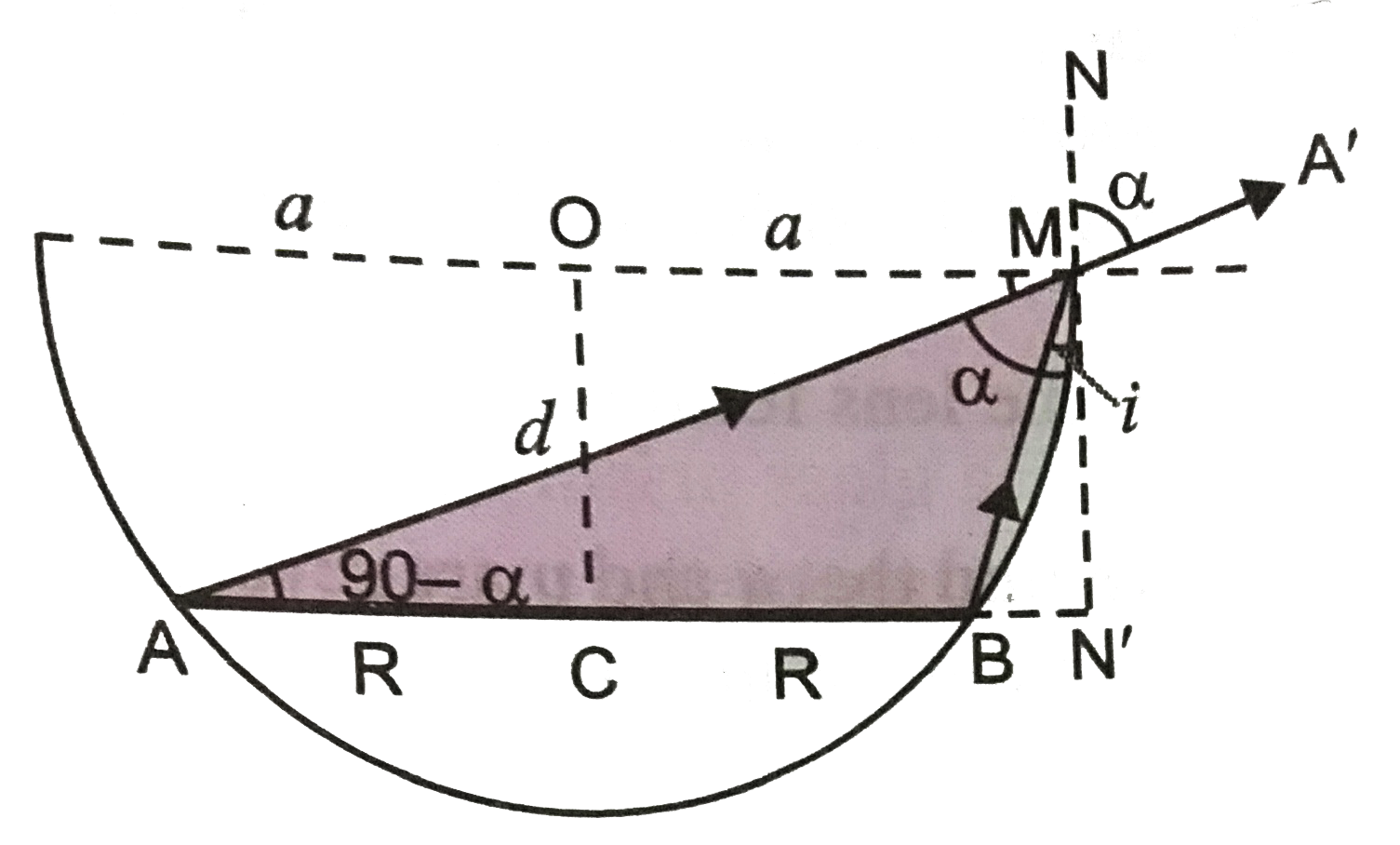 .View Solution
.View SolutionQuestion 332
In may experimental set-ups the source and screen are fixed at a distance say D and the lens is movable. Show that there are two positions for the lens for which an image is formed on the screen. Find the distance between these points and the ratio of the image sizes for these two points.View SolutionQuestion 334
A myopic adult has a far point at 0.1m. His power of accomodation is 4 diopters.
(i) What power lenses are required to see distant objects ?
(ii) What is his near point without glasses ?
(iii) What is his near point with glasses ? (Take the image distance from the lens of the eye to the retina to be 2 cm).View SolutionQuestion 341
A spherical of radius of curvature R, separates a rarer and a denser medium as shown in Fig. Complete the path of the incident ray of light, showing the formation of a real image. Hence derive the relation connecting object distance u, image distance v, radius of curvature R and the refractive indices n1andn2 of the two media. Briefly explain how the focal length of a convex lens changes with increase in wavelength of incident light.
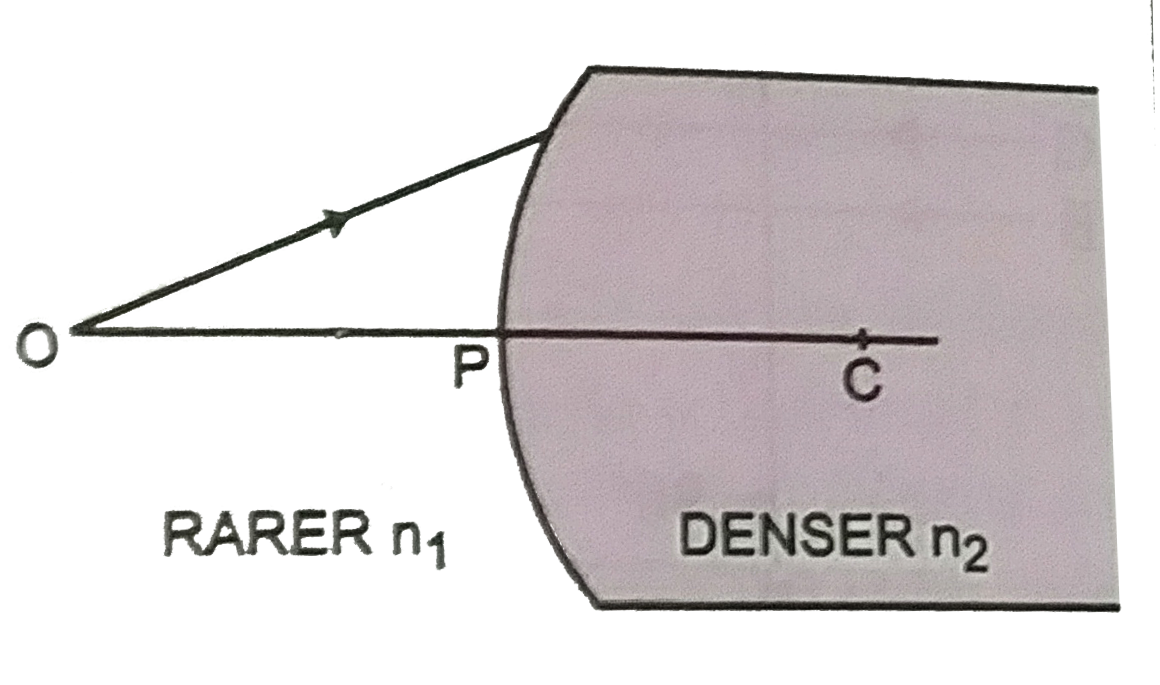 .View Solution
.View SolutionQuestion 348
A spherical of radius of curvature R, separates a rarer and a denser medium as shown in Fig. Complete the path of the incident ray of light, showing the formation of a real image. Hence derive the relation connecting object distance u, image distance v, radius of curvature R and the refractive indices n1andn2 of the two media. Briefly explain how the focal length of a convex lens changes with increase in wavelength of incident light.
 .View Solution
.View SolutionQuestion 365
The mixture of a pure liquid and a solution in a along vertical column (i.e., horizontal dimensions lt lt vertical dimensions) produces diffusion of solute particles and hence a refractive index gradient along the vertical dimension. A ray of light entering the column at right angles to the vertical is deviated from its original path. Find the deviation in travelling a horizontal distance d<<h, the height of the column.View SolutionQuestion 366
If light passes near a massive object, the gravitational interaction causes a bending of the ray. This can be thought of as happening due to a change in the effective refractive index of the medium given by n(r)=1+2GM/rc2
where r is the distance of the point consideration from the centre of the mass of the massive body, G is the universal gravitational constant, M the mass of the body and c the speed of light in vacuum. Considering a spherical object, find the deviation of the ray from the original path as it grazes the object.View SolutionQuestion 367
An infinitely long cylinder of radius R is made of an unusal exotic material with refractive index (−1), Fig. The cylinder is placed between two planes whose normals are along the y direction. The center of the cylinder O lies along the y-axis. A narrow laser beam is directed along the y-direction from the lower plate. The laser source is at a horizontal distance x from the diameter in the y direction. Find the range of x such that light emmited from the lower plane does not reach the upper plane.
 .View Solution
.View SolutionQuestion 368
(i) Consider a thin lens placed between a source (S) and an observer (O), Fig. Let the thickness of the lens vary as w(b)=w0−b2∝, where b is the vertical distance from the pole. w0 is a constant. Using Fermat's principle, i.e., the time of transit for a ray between the source and observer is an exptremum, find the condition that al paraxial rays starting from the source will converge at a point O on the axis. Find the focal length.
(ii) A gravitational lens may be assumed to have a varying width of the form
w(b)=k1In(k2b)bmin<b<bmaxw(b)=k1In(k2bmin)b<bmin
Show that an observer will see an image of a point object as a ring about the center of the lens with an angular radius β=√(n−1)k1uvu+v.
 .View Solution
.View SolutionQuestion 369
A small candle 2.5cm in size is placed 27cm in front of a concave mirror of radius of curvature 36cm. At what distance from the mirror should a screen be placed in order to receive a sharp image ? Describe the nature and size of the image. If the candle is moved closer to the mirror, how would the screen have to be moved ?View SolutionQuestion 371
A tank is filled with water to a height of 12.5cm. The apparent depth of a needle lying at the bottom of the tank is measured by a microscope to be 9.4cm. What is the refractive index of water ? If water is replaced by a liquid of refractive index 1.63 upto the same height, by what distance would the microscope have to be moved to focus on the needle again ?View SolutionQuestion 374
A prism is made of glass of unknown refractive index. A parallel beam of light is incident on a face of the prism. By rotating the prism, the minimum angle of deviation is measured to be 40∘. What is the refractive index of the prism ? If the prism is placed in water (μ=1.33), predict the new angle of minimum deviation of the parallel beam. The refracting angle of prism is 60∘.View SolutionQuestion 380
A person with a normal near point (25cm) using a compound microscope with an objective of focal length 8.0mm and eye piece of focal length 2.5cm can bring an object placed 9.0cm from the objective in sharp focus. What is the separation between the two lenses ? Calculate the magnifying power of the microscope ?View SolutionQuestion 382
A gaint refrecting telescope at an observatory has an objective lens of focal length 15m. If an eye piece lens of focal length 1cm is used, find the angular magnification of the telescope.
If this telescope is used to view the moon, what is the diameter of image of moon formed by objective lens ? The diameter of the moon is 3.42×106m and radius of lunar orbit is 3.8×108m.View SolutionQuestion 383
Use the mirror equation to deduct that :
(a) an object between f and 2f of a concave mirror produces a real image beyond 2f.
(b) a convax mirror always produces a virtual image independent of the location of the object.
( c) the virtual image produced by a convex mirror is always diminished in size and is located between the focus and the pole.
(d) an object placed between the pole and focus of a concave mirror produces a virtual and enlarged image.View SolutionQuestion 384
A small pin fixed on a table top is viewed from above from a distance of 50cm. By what distance would the pin appear to be raised, if it be viewed from the same point through a 15cm. Thick glass slab held parallel to the table ? μ of glass 1.5 Does the answer depend on location of the slab ?View SolutionQuestion 385
(a) Fig. shows a cross-section of a 'light pipe' made of a glass fibre of refractive index 1.68. The outer covering of the pipe is made of a material of refractive index 1.44. What is the axis of the pipe for which total reflection inside the pipe take place as shwon.
(b) What is the answer if there is no outer covering if the pipe ?
 View Solution
View SolutionQuestion 386
Answer the following questions :
(a) You have learnt that plane and convex mirrors produce virtual images of objects. Can they produce real images under some circumstances ? Explain.
(b) A virtual image, we always say, cannot be caught on a screen. Yet when we see a virtual image, we bring it to screen i.e. retine of our eye. Is there a contradiction ?
( c) A diver under water looks obliquely at a fisherman standing on the bank of a lake. Would the fisherman look taller or shorter than what he actually is ?
(d) Does the apparent depth of a tank of water change if viewed obliquely ? If so, does the apparent depth increase or decrease ?
( e) The refractive index of diamond is much greater than that of ordinary glass. Is this fact of some use to a diamond cutter ?View SolutionQuestion 389
a) Determine the effective focal length of the combination of the two lenses in Exercise, if they are placed 8.0cm apart with their principal axes coincident. Does the answer depend on which side of the combination a beam of paralel light is incident? Is the notions of effective focal length of this system useful at all?
b) An object 1.5 cm in size is placed on the side of the convex lens in the arrangement a) above. The distance between the object and the convex lens is 40cm. Determine the magnification produced by the two-lens system, and the size of the image. View SolutionQuestion 392
For a normal eye, the far point is at infinity and the near point of distinct vision is about 25cm in front of the eye. The cornea of the provides a converging power of about 40dioptre and the least converging power of eye lens behind the cornea is about 20dioptre. From this rough data, estimate the range of accommodation (i.e., the range of converging power of the eye lens) of a normal eye.View SolutionQuestion 396
A man with normal near point (25 cm) reads a book with small print using a magnifying glass : a thin convex lens of focal length 5cm.
(a) What are the closest and the farthest distances at which he can read the book when viewing through the magnifying glass ?
(b) What is the maximum and the minimum angular magnifications (magnifying powers) possible using the above simple microscope ?View SolutionQuestion 397
A cardsheet divided into squares each of size 1mm2 is being viewed at a distance of 9cm through a magnifying glass (a conerging lens of focal length 10cm) held close to the eye.
(a) What is the magnification produced by the lenas ? How much is the area of each square to the virtual image ?
(b) What is the angular magnification (magnifying power) of the lens ?
( c) Is the magnification in (a) equal to the magnifying power in (b) ? ExplainView SolutionQuestion 400
a) The anlge subtended at the eye by an object is equal to the angle subtended at the eye by the virtual image produced by a magnifying glass. In what sense then does a magnifying glass provide angular magnifications?
b) in viewing through a magnifying glass, one usually positions one's eyes very close to the lens. Does angular magnification change if the eye is moved back?
c) magnifying power of a simple microscopes is inversely proportional to the focal length of the lens. What then stops us from using a convex lens of smaller and smaller focal length and achieving greater and greater magnifying power?
d) Why must both the objective and the eyepiece of a compound microscope have short focal lengths?
e) When viewing through a compound microscope, our eyes should be positioned not on the eyepiece but a short distance away from it fot best veiwing. Why? How much should be that short distance between the eye and eyepiece?View SolutionQuestion 402
A small telescope has an objective lens of focal length 140cm and eye piece of focal length 5.0cm. What is the magnifying power of telescope for viewing distant objects when
(a) the telescope is in normal adjustment (i.e. when the image is at infinity)
(b) the final image is formed at the least distance of distinct vision (25cm).View SolutionQuestion 403
(a) For the telescope described what is the separation between the objective lens and eye piece ?
(b) If this telescope is used to view a 100m tall tower 3km away, what is the height of the image of the tower formed by the objective lens ?
(c ) What is the height of the final image of the tower if it is formed at 25 cm ?View SolutionQuestion 406
Fig. shows an equiconvex lens (of refractive index 1.5) in contact with a liquid layer on top of a plane mirror. A small needle with its tip on the principal axis is moved along the axis until its inverted image is found at the position of the needle. The distance of the needle from the lens is measured to be 45.0cm. The liquid is removed and the experiment is repeated. The new distance is measured to be 30.0cm. What is the refractive index of the liquid ?
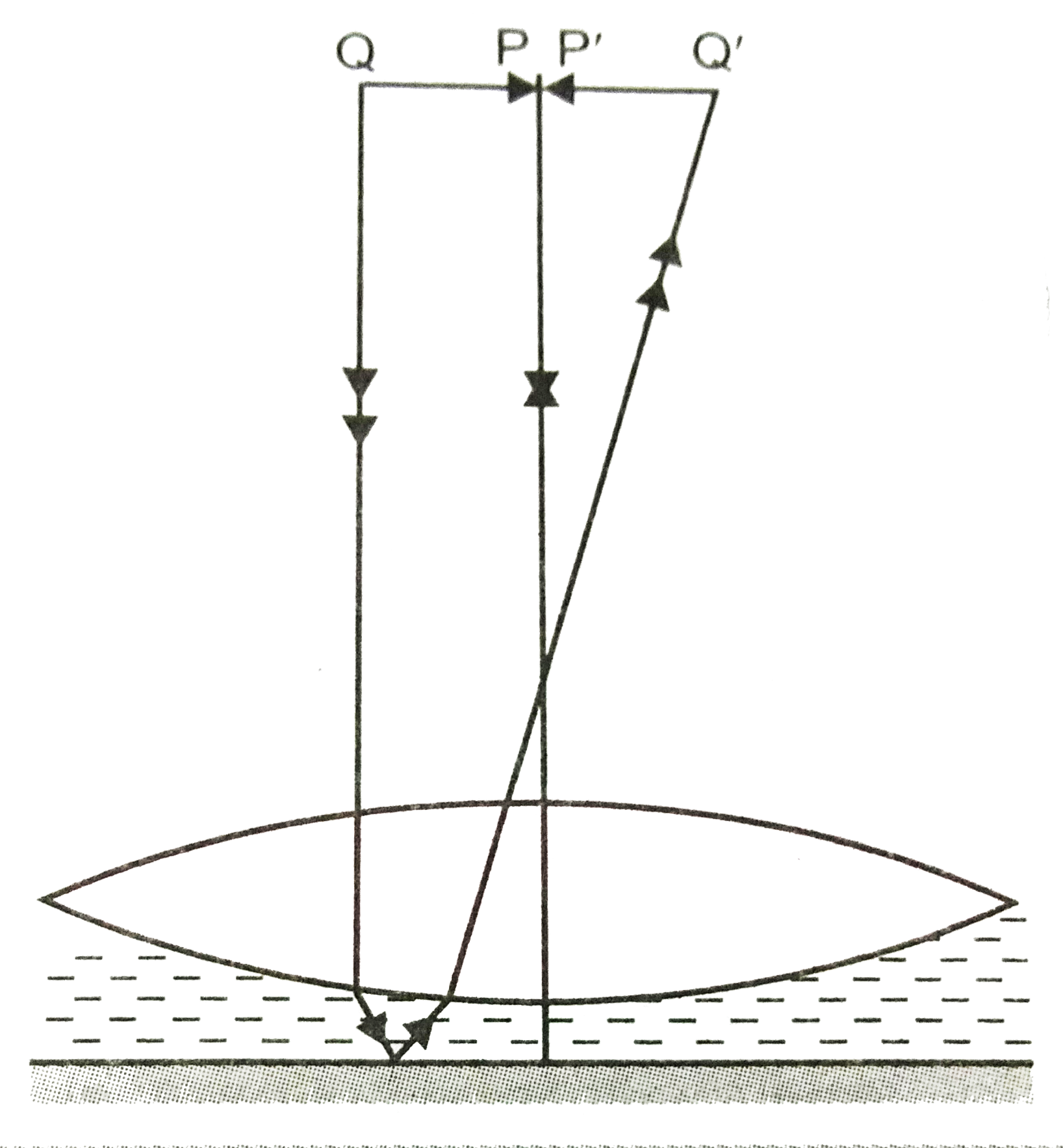 View Solution
View SolutionQuestion 407
Figure shows an irregular block of material of refractive indec √2. A ray of light strikes the face AB as shown. After refraction, it is incident on a spherical surface CD of radius of curvature 0.4 m and enters a medium of refractive index 1.514 to meet PQ at E. Find the distance OE up to two places of decimal.
 View Solution
View SolutionQuestion 408
An equiconvex lens with radii of curvature of magnitude R each is put over a liquid layer poured on top of a plane mirror. A small needle, with its tip on the principal axis of the lens, is moved along the axis until its inverted real image coincides with the needle itself. The distance of the needle from the lens is measured to be 'a'. On removing the liquid layer and repeating the experiment the distance is found to be 'b'.
Given that the two values of distances measured represent the focal length values in the two cases, obtain a formula for the refractive index of the liquid.
 View Solution
View SolutionQuestion 419
A boy 1.5m tall with his eye level at 1.38m stands before a mirror fixed on a wall. Indicate by means of a ray diagram how the mirror should be positioned so that he can view himself fully. What should be the minimum length of the mirror ? Does the answer depend on the eye level ?View SolutionQuestion 429
An object of height h is held before a spherical mirror of focal length |f|=40cm. The image of the object produced by the mirror has same orientation as the object and has height=0.2h. Is the image real or virtual ? Is the image on the convex or concave? What is focal length of mirror with proper sign?View SolutionQuestion 430
a concave mirror of focal length 20cm and a convex mirror of focal length 15cm are placed 50cm apart, such that the two mirrors face eaachother. An object is placed exactly midway between them. Fing the nature and position of image formed by reflection first at concave mirror and then at convex mirror. View SolutionQuestion 438
A mobile phone lies along the principal axis of a concave mirror as shown in Fig. Show by suitable diagram, the formation of its image. Explain why the magnification is not uniform, and distortion will occur depending on the location of the mobile with respect to the mirror.
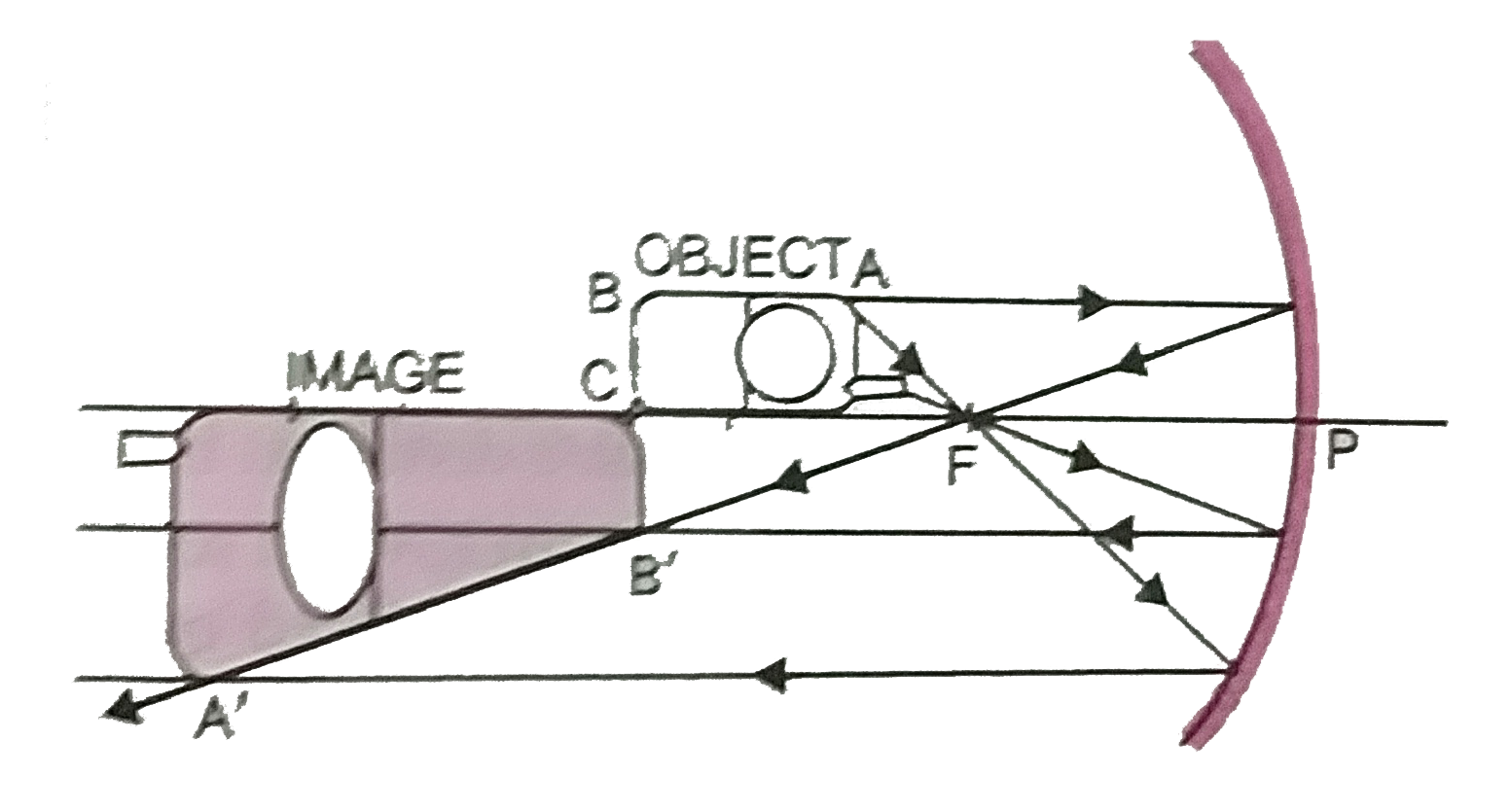 View Solution
View Solution
All Exercises from PRADEEP PHYSICS (HINGLISH) Class 11 PHYSICS RAY OPTICS
- (COMPETITION)COMPREHENSION
- (COMPETITION)MULTIPLE CHOICE
- (EXEMPLAR) MULTIPLE CHOICE
- (TEST YOUR GRIP)FILL IN THE BLANKS (B)
- (TEST YOUR GRIP)FILL IN THE BLANKS (C)
- (TEST YOUR GRIP)FILL IN THE BLANKS (D)
- (TEST YOUR GRIP)FILL IN THE BLANKS(A)
- (TEST YOUR GRIP)MULTIPLE CHOICE (B)
- (TEST YOUR GRIP)MULTIPLE CHOICE (C)
- (TEST YOUR GRIP)MULTIPLE CHOICE (D)
- (TEST YOUR GRIP)MULTIPLE CHOICE(A)
- (TEST YOUR GRIP)MULTIPLE CHOICE(SEC -A)
- ASSERTION-REASON QUESTION
- INTEGER QUESTION
- PROBLEM FOR PRACTICE(A)
- PROBLEM FOR PRACTICE(B)
- PROBLEM FOR PRACTICE(C)
- PROBLEM FOR PRACTICE(D)
- (NCERT)EXERCISE WITH SOLUTION
- (NCERT)LONG ANSWER
- (NCERT)SHORT ANSWER
- (NCERT)VERY SHORT ANSWER
- CONCEPTUAL PROBLEM(A)
- CONCEPTUAL PROBLEM(B)
- CONCEPTUAL PROBLEM(C)
- CONCEPTUAL PROBLEM(D)
- HIGHER THINKING ORDER
- LONG ANSWER (A)
- LONG ANSWER (B)
- LONG ANSWER (C)
- LONG ANSWER (D)
- SAMPLE PROBLEM(A)
- SAMPLE PROBLEM(B)
- SAMPLE PROBLEM(C)
- SAMPLE PROBLEM(D)
- SHORT ANSWER(A)
- SHORT ANSWER(B)
- SHORT ANSWER(C)
- SHORT ANSWER(D)
- SOLVED EXAMPLE(A)
- SOLVED EXAMPLE(B)
- SOLVED EXAMPLE(C )
- SOLVED EXAMPLE(D)
- VERY SHORT (A)
- VERY SHORT ANSWER (B)
- VERY SHORT ANSWER (C)
- VERY SHORT ANSWER (D)
 .
. .
.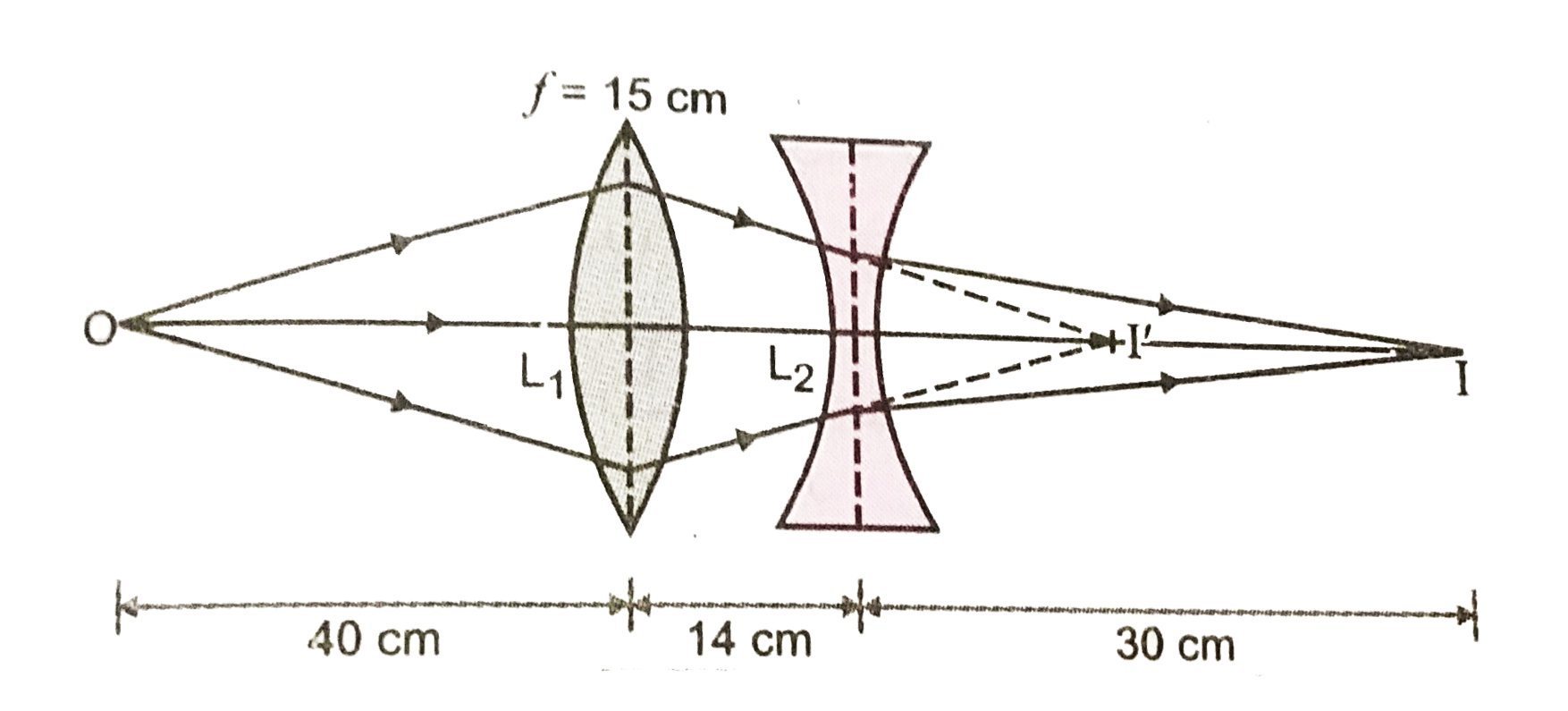 .
.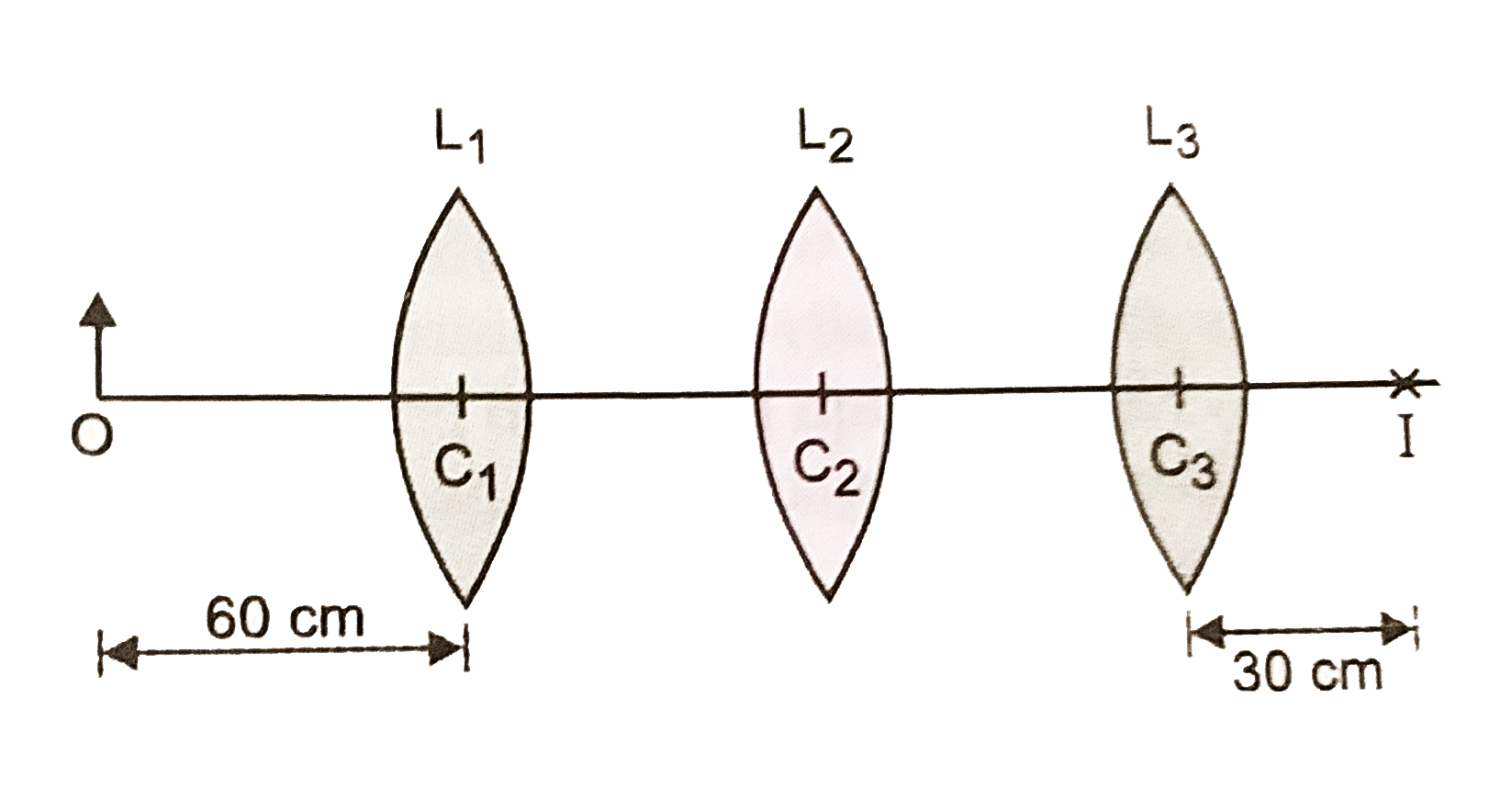 .
.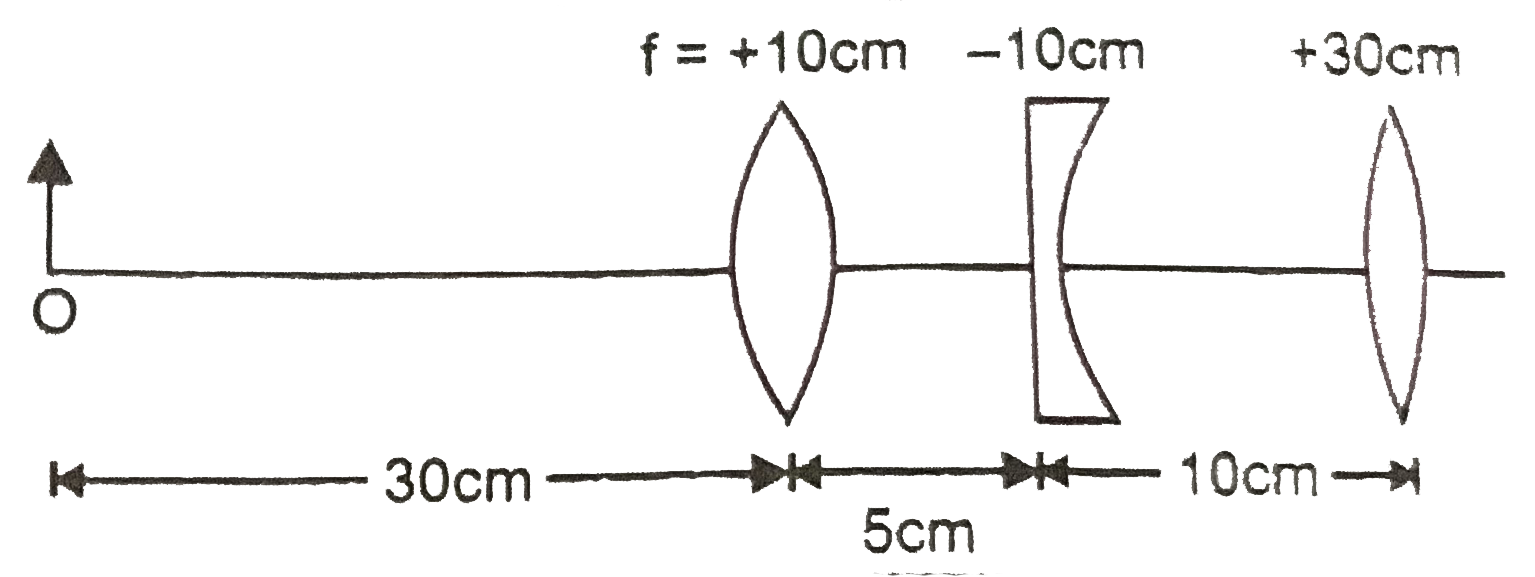 .
.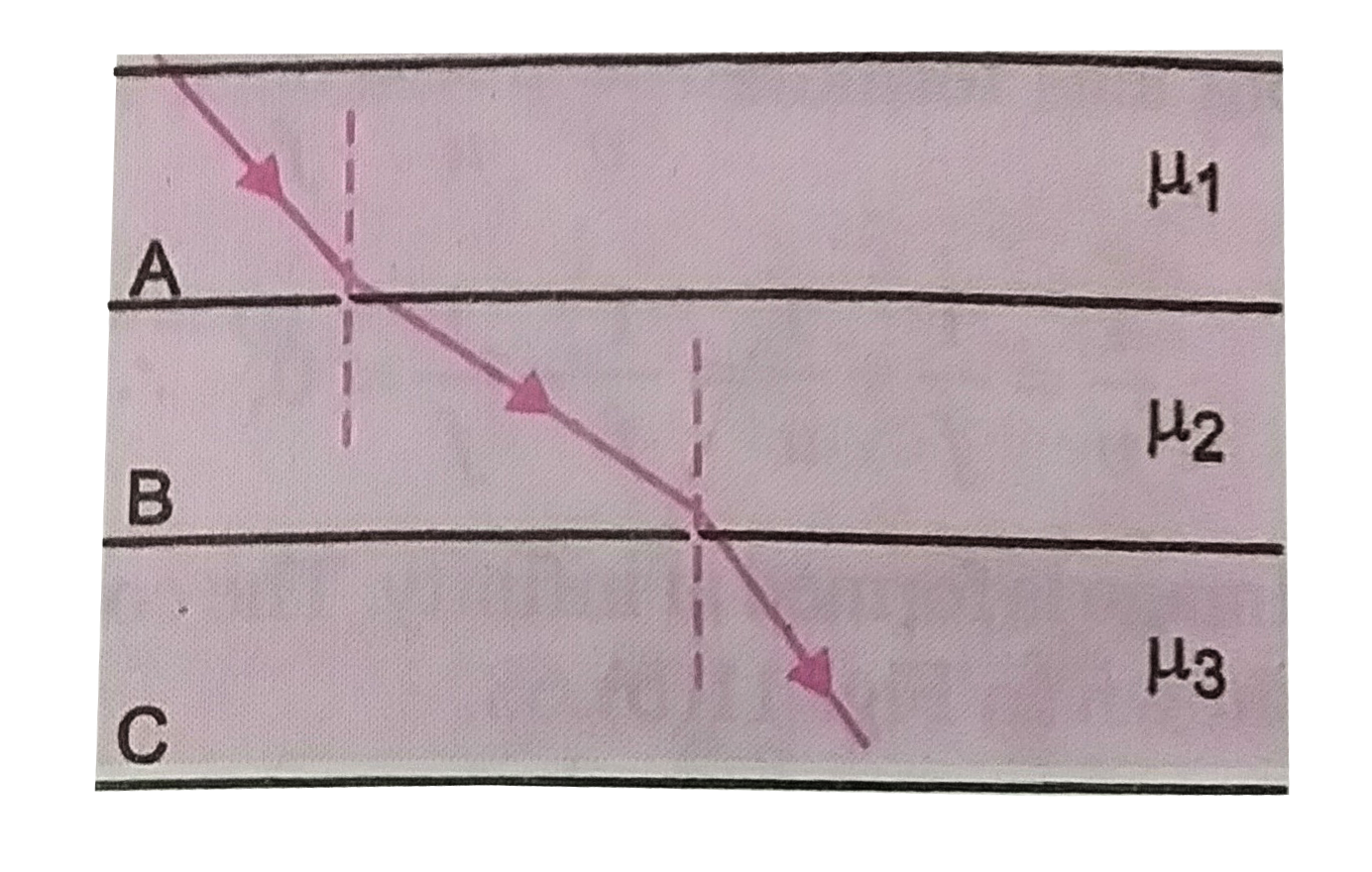 .
.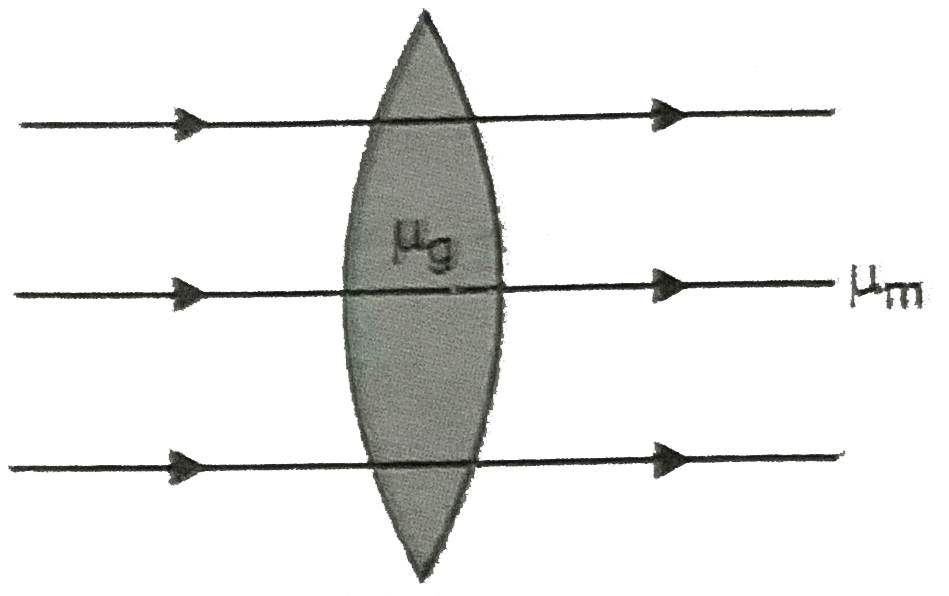 .
.
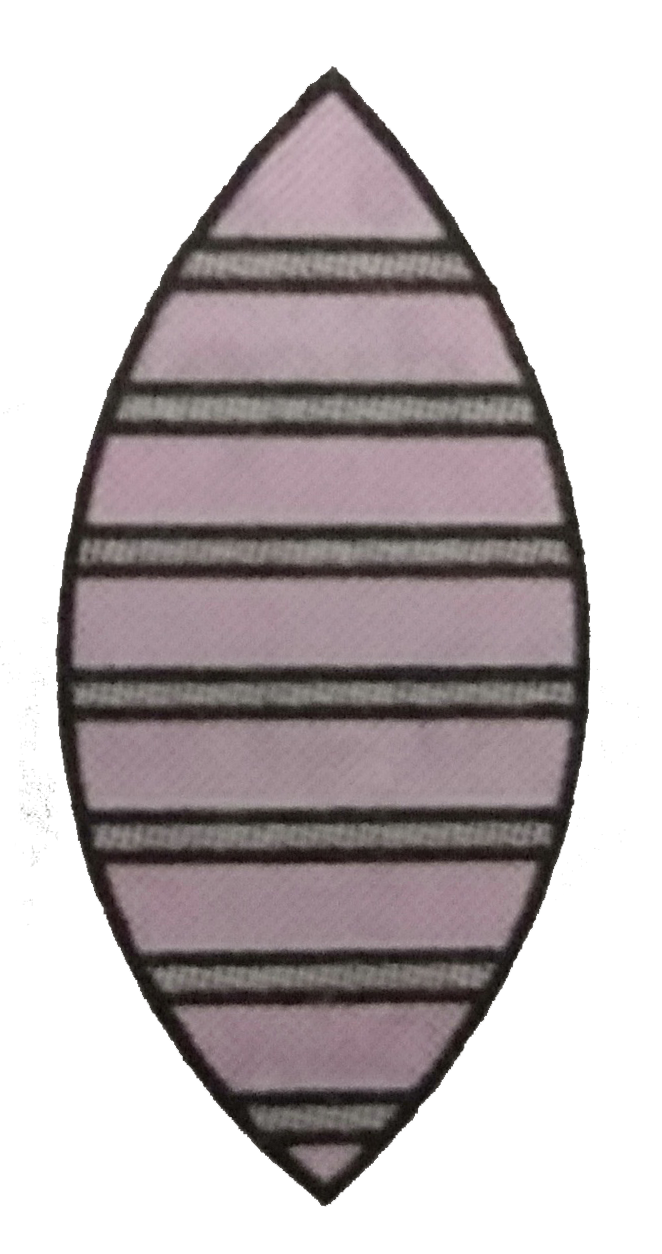
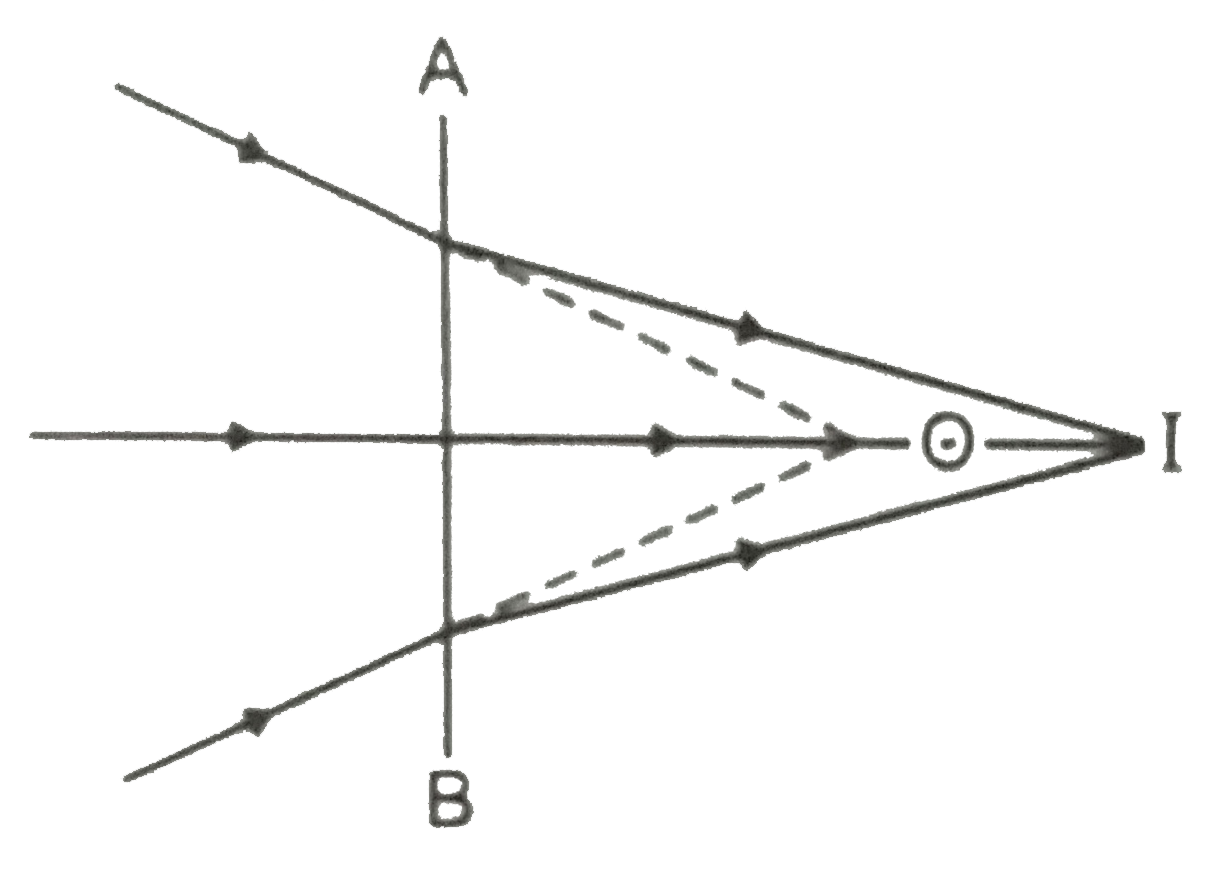
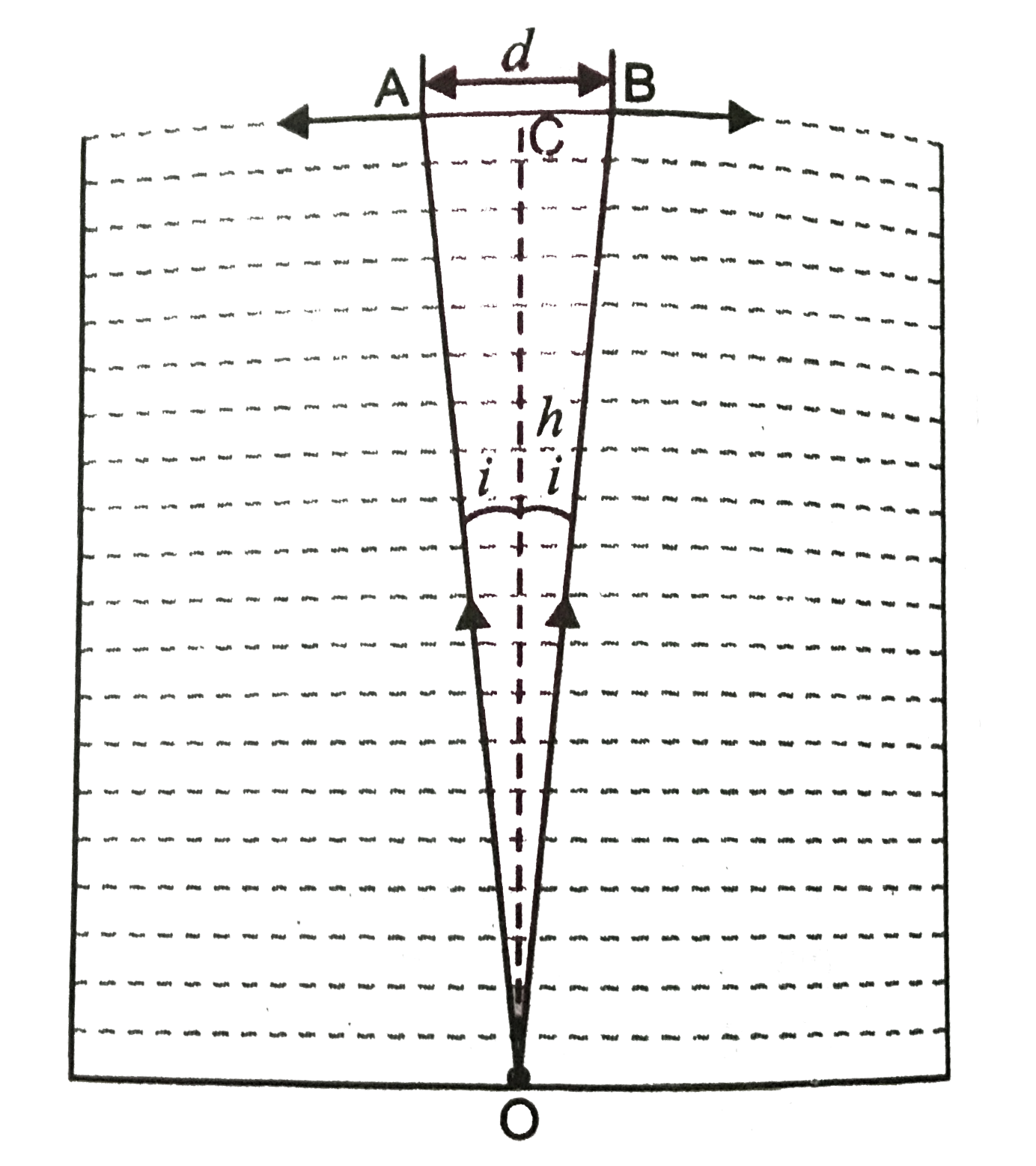 .
.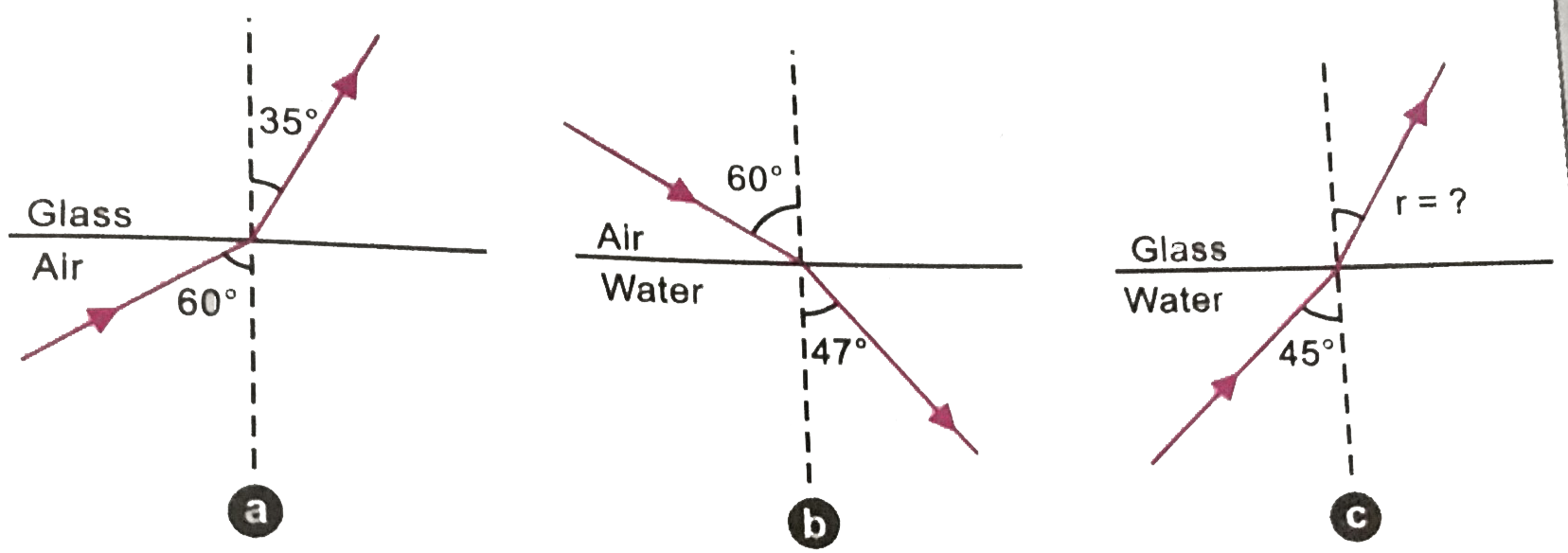 .
.